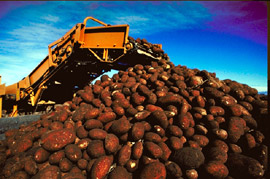
|

農業
- アメリカにおける農業の効率
- アメリカにおける農業の担い手
- 大規模企業農場の発展
- マイノリティの農場経営者
- 農業助成金
- 「平和のための食糧」プログラム
- アメリカの主要な農作物
- 主要な農作物:トウモロコシ
- アメリカの主要な農作物:大豆
- アメリカの主要な農作物:小麦
- アメリカの主要な農作物:綿花
- 綿の播種(はしゅ)と収穫
- アメリカの主要な農作物:米
- アメリカにおける米の栽培方法
- アメリカにおける酪農
- アメリカにおけるチーズの生産
- アメリカにおける鳥肉・食肉の生産
- 肉牛の飼育
- 工場的農業
- アメリカにおける農業の機械化
- アメリカにおけるバイオテクノロジーと農業
- アメリカにおける有機農業
- ファームエイド
|

Throughout the West, there are many large-scale farms.
Photo Courtesy of the United States Department of Agriculture. Photo by Gene Alexander.
Agricultural Subsidies
In the early 1950s, American farms produced huge crop surpluses. This drove down the prices farmers could get for their crops. In order for farmers to sell their crops at a profit, crop surpluses had to be eliminated. Subsequently, the Soil Bank program was created in 1956 to pay (subsidize) farmers not to grow certain crops. In theory, as crop supplies dwindled, the price farmers got for their crops would increase. In reality, due to improving farm efficiency the subsidy program had little effect. Even though less land was being used for some crops, the yield on cultivated land increased dramatically. Direct payment to farmers continued to increase in the 1970s. The main crops farmers were paid not to grow were feed grain, cotton, and wheat. By 2000, annual subsidies to farmers had swelled to over 22 billion dollars a year.
|
言葉の説明:
crop surplus
|
Soil Bank
|
| ポッドキャスト ダウンロード:
英語
| 日本語
|
|
文書 |
ビデオクリップ |
図表 |
写真 |
地図
|
|

